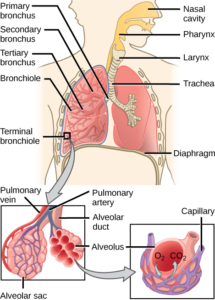The structure and function of the respiratory system is the first dash point under the dot point “respiratory system”. The structure of the respiratory system greatly enhances its ability to achieve its function. The function of the system is to enable the transfer of oxygen into the blood and the removal of carbon-dioxide out of the blood.
Structure of the respiratory system
The respiratory system consists of the following organs: nasal cavity, pharynx, larynx, trachea, bronchi, bronchioles, and alveoli. These organs combine to allow gas exchange to occur between the lungs and the circulatory system.
The nasal cavity is where air travels through and is warmed, while the small hairs in the cavity remove any small particles, such as dust or bugs.
The pharynx is where the nasal cavity and the oral cavity combine and allows for the movement of both air, food and liquid (the epiglottis is used to close off the air way when swallowing).
The larynx, also known as the voice box, is used to make sound and to talk.
The trachea is the main air pipe that brings air down to the lungs. The trachea then spits into two (2) main bronchi or bronchus, which continue to branch down to bronchioles. These bronchioles then bring the air to the alveoli which have a very large porous surface (it has pores or holes in it for the exchange of gas), which are lined with fluid. Each alveoli is surrounded by a mesh of capillaries to allow for gas exchange into the circulatory system.
Function of the respiratory system
The function of the respiratory system is to allow us to breath and promote gas exchange with the circulatory system. This is achieved by having a large surface area to value ratio caused by the alveoli. This large surface area allows for a large area where gas can be exchanged. During gas exchange oxygen is transferred to the circulatory system, while carbon-dioxide is removed.
The respiratory system will increase the depth of breath in response to physical activity. This increase the number of alveoli being used for gas exchange and, therefore, increases the amount of oxygen transferred to the blood and carbon-dioxide removed.
The respiratory system will also increase the breathing rate allowing for a faster change of gas inside the lungs, which increases the amount of gas exchange per minute allowing for higher delivery of oxygen to the working muscle. This improves movement efficiency of the muscles.

